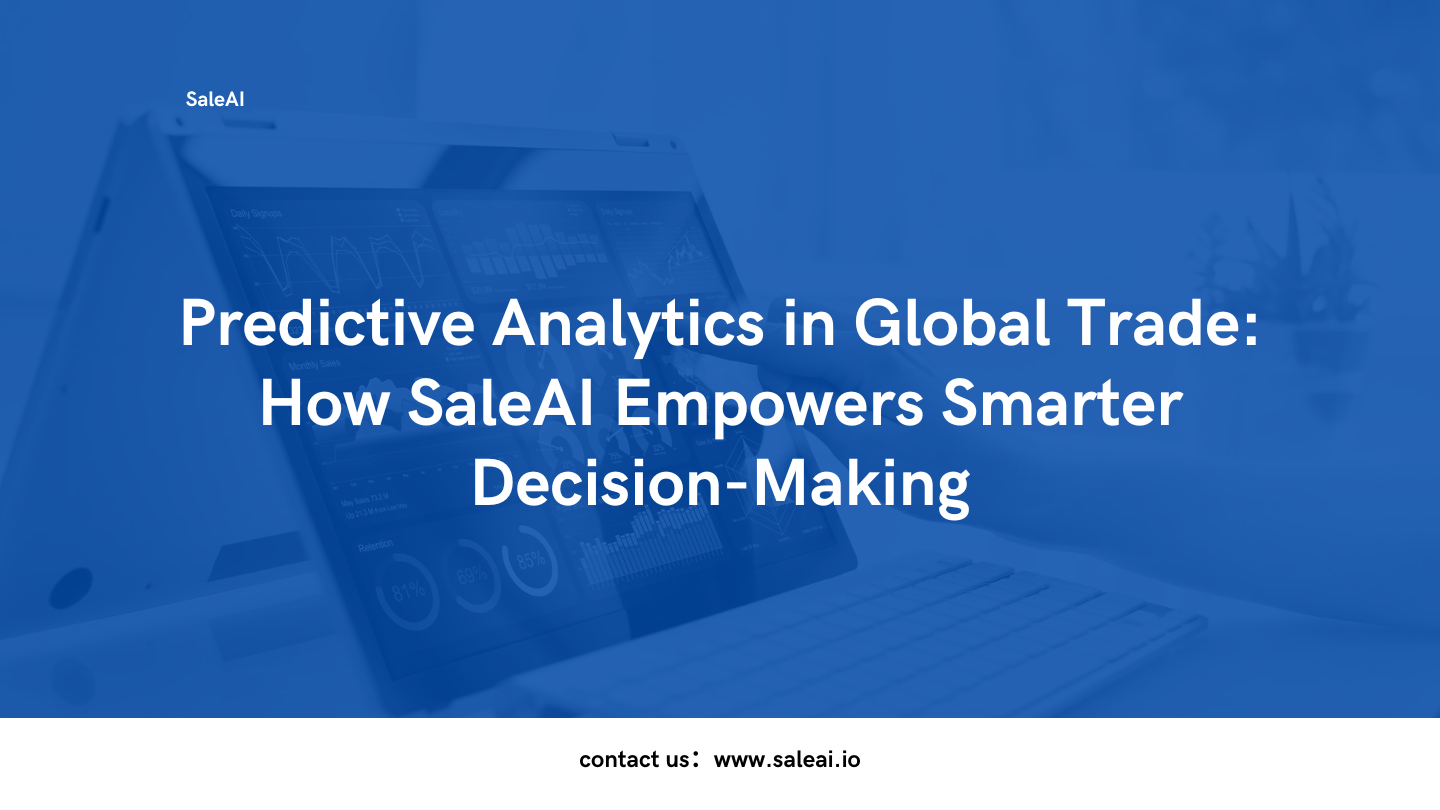The New Era of Predictive Analytics in Global Trade
The business world is transitioning from reactive strategies to proactive, data-driven approaches. Predictive analytics, powered by artificial intelligence, has emerged as a game-changing technology in global trade. By analyzing historical data, identifying patterns, and forecasting future trends, predictive analytics enables businesses to make smarter, faster, and more informed decisions.
At the forefront of this innovation is SaleAI, an advanced AI platform designed to empower exporters, suppliers, and logistics providers. With features like demand forecasting, competitor analysis, and supply chain optimization, SaleAI’s predictive analytics tools enable businesses to anticipate market shifts, reduce risks, and uncover new opportunities.
What Is Predictive Analytics in Global Trade?
Predictive analytics involves using data, statistical algorithms, and machine learning techniques to predict future outcomes based on historical data. In the context of global trade, it provides actionable insights to:
- Forecast product demand in specific regions.
- Identify procurement trends and buyer behavior.
- Anticipate supply chain disruptions.
- Monitor competitors’ market activities.
By leveraging predictive analytics, businesses can shift from responding to challenges to proactively addressing them, gaining a competitive edge in the global market.
How SaleAI Integrates Predictive Analytics
a. Demand Forecasting with TradeLink AI Insights
- Market Demand Analysis: Predict which regions will see increased demand for your products in the coming months.
- Customs Data Insights: Analyze billions of customs records to identify trade patterns and procurement behaviors.
- Seasonal Trends: Understand how regional demand fluctuates based on seasonality, events, or economic shifts.
b. Risk Mitigation with Real-Time Alerts
- Supply Chain Disruptions: Anticipate risks such as shipment delays, inventory shortages, or regulatory changes.
- Market Volatility: Monitor currency fluctuations, trade tariffs, and geopolitical events to reduce exposure to risks.
- Competitor Risks: Use predictive analytics to assess competitors’ strategies and adapt your approach accordingly.
c. Procurement and Inventory Optimization
- Supplier Reliability: Predict supplier performance based on past data, ensuring you choose partners who consistently deliver.
- Inventory Management: Avoid overstocking or stockouts by forecasting demand and aligning inventory levels with customer needs.
d. Competitor and Buyer Behavior Analysis
- Competitive Intelligence: Track competitors’ trade flows, pricing strategies, and market share to predict their next moves.
- Buyer Trends: Understand how buyer preferences evolve over time, enabling you to tailor products and marketing campaigns.
Real-World Applications of Predictive Analytics with SaleAI
a. Exporters: Expanding into New Markets
An exporter uses SaleAI’s TradeLink AI Insights to predict emerging demand for their products in South America. By entering the market early, they gain a first-mover advantage and establish a strong presence before competitors.
b. Suppliers: Managing Procurement Risks
A supplier leverages predictive analytics to assess which of their procurement partners are likely to face delays due to regulatory changes. This allows them to proactively diversify their supply chain and avoid disruptions.
c. Logistics Providers: Optimizing Delivery Routes
A logistics company uses SaleAI to forecast shipment volumes in specific trade routes. By adjusting their fleet allocation and schedules, they reduce costs and improve delivery times.
d. E-Commerce Businesses: Enhancing Customer Experience
A cross-border e-commerce retailer uses SaleAI to predict which products will trend in different regions during the holiday season. They adjust their inventory and marketing campaigns accordingly, resulting in increased sales and customer satisfaction.
How Predictive Analytics Transforms Global Trade Strategies
a. Improved Decision-Making
With predictive analytics, businesses can base their decisions on data-driven insights rather than intuition. This reduces uncertainty and increases the accuracy of forecasts.
b. Enhanced Agility
Predictive models enable businesses to respond quickly to market changes, ensuring they stay ahead of competitors and capitalize on new opportunities.
c. Risk Reduction
By identifying potential risks before they occur, businesses can take proactive measures to mitigate their impact, safeguarding operations and profitability.
d. Cost Efficiency
Forecasting demand and optimizing resources help businesses minimize waste, reduce operational costs, and maximize ROI.
e. Competitive Advantage
Businesses that adopt predictive analytics gain an edge over competitors by anticipating market trends and adapting their strategies in real-time.
Why SaleAI Stands Out in Predictive Analytics
a. Comprehensive Data Coverage:
SaleAI analyzes billions of data points from customs records, procurement trends, and market activities, ensuring you have the most accurate and up-to-date insights.
b. AI-Powered Algorithms:
SaleAI’s machine learning models continuously improve over time, delivering increasingly precise predictions for your business.
c. User-Friendly Interface:
Despite its advanced capabilities, SaleAI is designed to be intuitive, making predictive analytics accessible to businesses of all sizes and technical expertise.
d. Seamless Integration:
SaleAI combines predictive analytics with tools for lead generation, market research, and supply chain management, creating a unified platform for global trade success.
e. Proven Track Record:
Many businesses across industries trust SaleAI to optimize their operations, reduce risks, and achieve sustainable growth.
Industries Benefiting from Predictive Analytics with SaleAI
a. Manufacturing
Predict demand for finished goods, optimize raw material procurement, and streamline production schedules.
b. Retail and E-Commerce
Forecast customer preferences, manage seasonal inventory, and tailor marketing campaigns to regional trends.
c. Logistics and Supply Chain
Anticipate shipment volumes, optimize delivery routes, and mitigate supply chain disruptions.
d. Agriculture
Identify high-demand regions for agricultural exports and optimize resource allocation for seasonal variations.
Conclusion: Stay Ahead with Predictive Analytics by SaleAI
In the ever-evolving landscape of global trade, predictive analytics is no longer optional—it’s essential. With SaleAI’s predictive analytics tools, businesses can anticipate market trends, mitigate risks, and make data-driven decisions that drive growth.
From forecasting demand to optimizing supply chains, SaleAI empowers businesses to transform challenges into opportunities and secure a competitive edge in the global marketplace. Don’t just react to the future—predict it with SaleAI.





